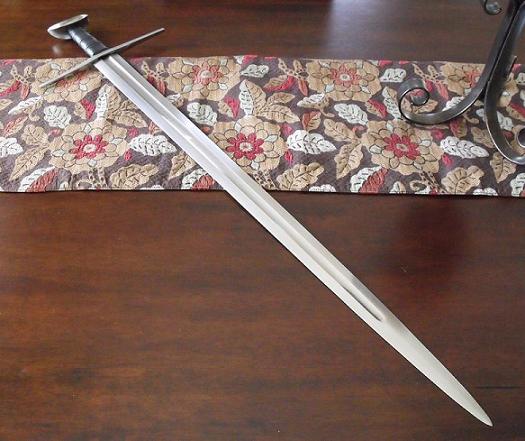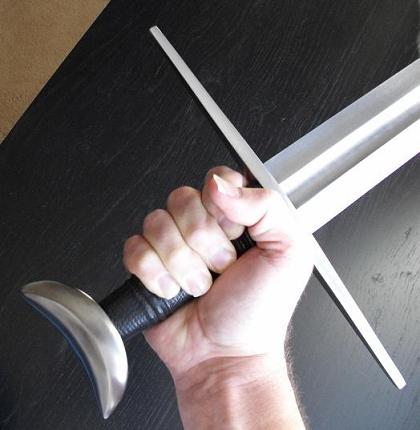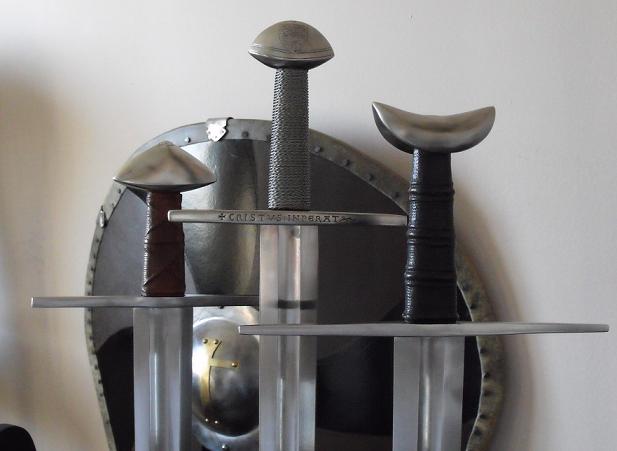This sword replica was built by Arms and Armor (A&A) based in Minneapolis, MN, USA, one of the most established companies in the business. It is a custom replica based on a 13th century sword found in somewhere in Western Germany. The most distinctive feature of this sword is its crescent shaped pommel, which is known to exist on only 3 surviving swords, but is represented more frequently in period Art. The distribution of this and similar sword types corresponds to the extent of the Empire at that time, as well as areas of Eastern Europe that are known to have been occupied by the Teutonic Knights. It is possible that the crescent shape of this pommel symbolizes St. Mary, the patron saint of the Teutonic Order. For more background details, including extensive development photos of the modern sword, see: http://www.myArmoury.com/talk/viewtopic.php?t=21804
The A&A sword is not an exact replica of the original – for example the guard has been tapered more toward the tips in ‘spikehilt’ fashion (according to my taste and period art) and the blade may not be as long (the original has a broken tip) – see comparison photo below. However, based on the very limited data that we have, it is an accurate representation of an early version of this unusual sword type. The combination of the crescent pommel, extra wide guard, and substantial blade make for a sword with a very dramatic and commanding presence. Although it is an elegant looking sword, every bit of it –-the big tapering blade, long spiky cross, and double-horned pommel-- could be used to maim, and visually proclaim ‘I am a weapon, made for intimidation and distruction’.
Measurements and Specifications
Overall Length: 40.2in/1021mm
Blade Length: 33.9in/862mm
Blade Width at Hilt: 2in/50mm
Grip Length: 4.6in/117mm
Guard Length: 10.3in/261mm
Center of Gravity: 5in/127mm in front of guard
Center of Percussion: ~21in/530mm (+/- 1in)
Weight: 3.1lbs/1425g
Oakeshott Typology: type XII blade, type O pommel, type 1 cross.
Handling Characteristics
Type XII swords are thought to represent an early compromise between the cut and the thrust, and this sword exemplifies these properties in a somewhat large single-handed sword. Its size and handling also puts it in a range suitable for cavalry use while remaining maneuverable enough for close encounters, so this seems to be the ‘all around, all purpose’ high medieval warsword.
As Craig Johnsson of A&A put it, this is a solid feeling sword. The weight of the blade is offset by a massive pommel, and more importantly, the overall weight (although on the high end for a single hand sword) is distributed very well. In addition to the profile taper (linear at first, gentle convex curve toward the tip), this sword possesses the strongest distal taper in blade thickness of any of the 3 A&A products I own so far. Starting from a blade thickness of ~5mm, it tapers down to less than 2mm toward the tip (I don’t have callipers so this is an estimate). Overall its blade geometry is similar to better known swords like the Albion Knight/Laird/Caithness line, but a just lot bigger and somewhat heavier. The sum of all this is a sword that feels very authoritative, but is still reasonably agile to handle dynamically and through guard transitions.
The sword also follows through fairly easily and accurately on the thrust, although one feels its weight on the shoulder when the arm is fully extended in half-speed drills (I use a suspended ring of cord for thrusting practice).
I have not tried cutting with it or thrusting against real targets (other than poking the tip through the box it arrived in) and likely will not subject this sword to harsh treatment, but with its dimensions, handling, and sharp integral edge, one would expect this sword to excel against medium and heavy targets. Moreover, the blade is surprisingly stiff and resistant to vibration, perhaps a combination of the narrow fuller, good harmonics, and the temper. The blade tapers to quite a fierce point that has been left slightly thick at the very tip, so one expects better than average thrusting performance for a sword of this era.
Nice sound effects too - the sword produces a woosh or a whistle, depending how fast it is swung, and rings with a sustained chime at the slightest touch against anything solid.
A final note on handling – in contrast to earlier Brazil nut swords, the length of the grip and the wideness of the pommel orthogonal the blade mitigate against the use of a handshake grip on this sword – it is clearly a ‘hammer grip’ sword. However one can shorten up the grip against the pommel and get a very comfortable, ergonomic support against the hand. It’s possible this would come into play more for a larger mailed fist filling the whole grip – but I don’t currently have the equipment to test this theory.
Fit and Finish
The components of this sword are tightly hitched together with no gaps, as one should expect from a company like A&A. When it comes to finish, I think some people can be disappointed by custom swords – the assumption is that you are paying more so everything should be better. But this does not account that the artist/craftsman is may be doing some aspects of the project for the first time on a made-to-order custom sword, and does not have the same practice they would have on a design they are more used to.
However, this is not the case here. In this sword, everything is executed perfectly and shows the best finish of the few custom-made swords I have handled. The fuller, the cutting surfaces of the blade, the cross, the pommel are all equally impressive, with no scratches, coarse grind marks, or unevenness. The unusual pommel – which was essentially hand sculpted from a block of metal – is actually smoother than it appears in some of Craig’s own photos – the apparent variations in shape arising from subtle changes of hue in the finish that look quite nice in real life. I have searched all over the blade and can only find one unexpected irregularity – a slight serration of the blade edge for 1CM near the tip.
Finally, the grip is something that Craig designed, coming up with the multiple triple-risers and deciding on black, which suits the somewhat sinister appearance of this sword. The grip is very positive – but I have not been practicing lately and need to develop some callouses to be completely comfortable with the ridges on this grip.
Conclusion
Despite being historically documented, and having possible Christian connections with the Teutonic Order, and possible saintly feminine imagery, there is something very ‘dark fantasy’ about this sword, calling up images of sorcerous swords from the Tolkien and Moorcock books that fired our youthful imaginations. Truly it would be a fearsome thing to see a Teutonic Knight with one of these in hand, charging toward you on horseback through the Prussian countryside.
It’s always a privilege to own a custom sword from a top-notch manufacturer, but to have such a unique design, and have it turn out so well in the details of blade geometry and finish, is simply a blessing. I feel very fortunate to own this sword, grateful to Craig Johnson and his colleagues for the obvious TLC put into the sword, and grateful for many pleasant exchanges of information, ideas, and photos with Craig leading up to the fruition of this project.
Finally, I dedicate this project -the making and documenting of this sword- to the memory of my father, who was ill and passed away just as things got rolling. http://yourlifemoments.ca/sitepages/obituary.asp?oid=450596

Comparison with Original.
Drawing courtesy of M Aleksić, Photo by Craig Johnson.

Sword in Profile

Blade-on view

Sword in Hand

With some other A&A swords in my collection